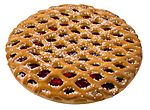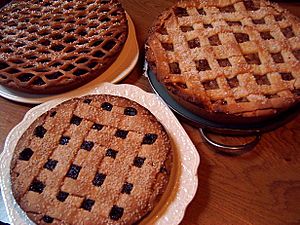Vlaai facts for kids

A cherry vlaai
|
|
| Course | Dessert |
|---|---|
| Place of origin | |
| Region or state | Limburg |
| Main ingredients | Yeast dough, fruits, berries |
Vlaai is a delicious sweet pie from a region called Limburg. This area is found in both the Netherlands and Belgium, and also in parts of Germany nearby.
Vlaai is made with a special dough and a tasty filling. It's usually round, about 26 to 31 centimeters across. You can find vlaai with many different fruit fillings, like cherry, apricot, or strawberries. Some kinds have a crumbly topping made of butter and sugar. Another popular type is rijstevlaai, which has a filling of cooked rice and custard.
People often eat vlaai for special events. In the Dutch part of Limburg, it's a common treat for birthdays. It's also sometimes served at funerals, often a dark plum vlaai.
Contents
The History of Vlaai
We don't know everything about how vlaai started. But we do know it's not just from Limburg. It has been around for a long time.
An Old Story About Vlaai
One of the oldest stories about vlaai is from the 1100s. This was during a time when a city in Belgium, Sint-Truiden, was under attack. The people of the city offered a vlaai to the attacking leader, Duke Godfried III. After he ate it, the duke stopped his attack! This story shows how old and special vlaai is.
Vlaai as a Special Treat
Until the middle of the 1900s, vlaai was a luxury. People in Limburg only ate it for celebrations. In the countryside, families often baked their own vlaai. They used traditional ovens called bakehouses.
Vlaai was usually served in the afternoon with coffee. People would often enjoy two or three different slices. After World War II, life became better for many. People started to eat vlaai more often.
How Vlaai Became Famous
Vlaai started to become well-known outside Limburg in the late 1800s. This was because more tourists visited the southern part of Dutch Limburg. Many tourists bought vlaai from local bakers to take home.
In 1986, the first vlaai shop opened in Amsterdam. Supermarkets also began selling vlaai, which helped make it even more popular. A woman named Maria Hubertina Hendrix, also known as 'Antje van de Stasie', helped a lot too. In the early 1900s, she sold her "Weerter vlaaitjes" at the train station in Weert. Travelers from all over the Netherlands learned about this tasty pie. Later, her vlaai was also sold in Nijmegen. There is even a statue of her in Weert, built in 1988.
See also
 In Spanish: Vlaai para niños
In Spanish: Vlaai para niños


